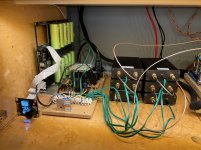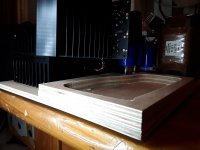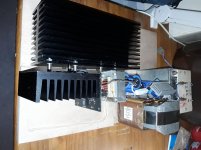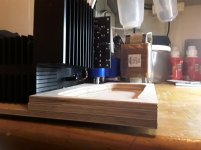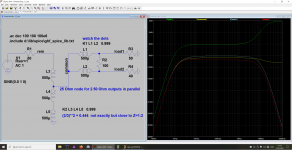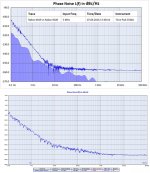Hi,
I have build a dual power supply with voltage regulator and battery so I can switch from battery to voltage regulator. In this way I keep the clocks continuously powered and can switch to battery power when I feel the need.
It works as a hot switch, the ps caps on the clock boards are enough to keep the clocks running without hiccups while switching to and from battery supply.
I have build a dual power supply with voltage regulator and battery so I can switch from battery to voltage regulator. In this way I keep the clocks continuously powered and can switch to battery power when I feel the need.
It works as a hot switch, the ps caps on the clock boards are enough to keep the clocks running without hiccups while switching to and from battery supply.
Attachments
Hello,
Just sharing some pics of Roon Nucleus power supply.
Using LL2771 for choke input in a LCRC configuration followed by a regulated supply made by Doede based upon the dddac supply.
Power output voltage around 16,5 volts so supply is similar to the clock supply.
With the clock supply i am using big Eaton supercap that is charged by a battery charger and when enough voltage is reached an Arduino controlled circuit will switch to an " audiophile supply "
Right now dont know if the Roon supply will benefit from adding a 60 plus F supercap.
I do know that reducing dc cable to the circuit is essential. It is really short between Doede's circuitboard and the dc input on the Roon chassis
I added a kind of wooden frame on top of the wooden board which is just 9 mm thick.
Dont know if it will add something but i wanna try adding some lead shot because still have some stock.
Greetings,Eduard
Just sharing some pics of Roon Nucleus power supply.
Using LL2771 for choke input in a LCRC configuration followed by a regulated supply made by Doede based upon the dddac supply.
Power output voltage around 16,5 volts so supply is similar to the clock supply.
With the clock supply i am using big Eaton supercap that is charged by a battery charger and when enough voltage is reached an Arduino controlled circuit will switch to an " audiophile supply "
Right now dont know if the Roon supply will benefit from adding a 60 plus F supercap.
I do know that reducing dc cable to the circuit is essential. It is really short between Doede's circuitboard and the dc input on the Roon chassis
I added a kind of wooden frame on top of the wooden board which is just 9 mm thick.
Dont know if it will add something but i wanna try adding some lead shot because still have some stock.
Greetings,Eduard
Attachments
Hi,
I have build a dual power supply with voltage regulator and battery so I can switch from battery to voltage regulator. In this way I keep the clocks continuously powered and can switch to battery power when I feel the need.
It works as a hot switch, the ps caps on the clock boards are enough to keep the clocks running without hiccups while switching to and from battery supply.
Hi! I have ordered this for doing the same. Didn´t want to just rely on regulator caps...there is low voltage drop accross the MOSFETs and I do not think the board can degrade performance, what do you guys think?
Modulo de conmutacion inteligente bidireccional de diodo Ideal de baja caida, fuente de alimentacion multipotencia de 15A|Piezas para herramientas| - AliExpress
best
Last edited:
I have simulated around this evening for the power splitter for the timepod low frequency extension.
It will be interesting to include parasitics and less close coupling.
It will be interesting to include parasitics and less close coupling.
Attachments
Last edited:
I just ran across this interesting paper: OPUS 4 | Space Qualified 5MHz Crystal Oscillators with Maximum Stability between 1 and 10 Seconds It has some good insights into low phase noise oscillators. His web site Electronic Projects for Fun – … because its great if it finally works !!! Homebrew Electronics, Ham Radio, RF Design, Test Equipment has some interesting homebrew tools he created to help the work on the oscillator project. Also some input on important details like using exotic transistors did not help.
Interesting, thank you. I am not qualified to evaluate his results, but the following drew my attention:
I know somebody who should read this passage twice, before making outlandish claims about "the best oscillator in the world".
The measurement of the close to carrier noise levels of -130dBc or less asks for nonstandard measurement techniques involving a cryogenic sapphire reference with an Allen deviation of less than 1-14 at 1s. Another important prerequisite is a lab environment with perfect thermal, electrical, magnetic, and mechanical shielding.
I know somebody who should read this passage twice, before making outlandish claims about "the best oscillator in the world".
>When it comes to extreme performance levels (like RAKON HSO14 and successors) even the FSWP reaches its limits. In fact, no general-purpose phase noise analyzer on the market can make reliable measurements of oscillators of the 10 -14 class (1 second Allen deviation). Specialized mixing, digitizing and correlation hardware, multiple, even cryogenic reference oscillators, extremely shielded and environmentally controlled lab environments can push the limits to -145dBc/1Hz. Techniques like this are discussed in the “Phase Noise Measurement Techniques Section” but are out of reach of most electronics labs, how well equipped they may be.
Funny that on RACON's web site for the HSO14 they show a plot made with a Timepod with another of their oscillators as a reference, and there is 15 dB of reserve for the timepod at 1 Hz.
< Ultra-stable oscillators HSO14 and HSO13 for ground based applications >
That does not mean that I did not like the FSUP or the FSWP. They don't do all sorts of wonderous things. But when UR is on the jury of your thesis, then..
I'm personally gone far into the south; I disliked the Colpitts with output taken from the crystal current and preferring the Driscoll that also outputs the crystal current but uses it also for feedback. That brought me under heavy fire in a timenuts article. 🙂
That does not mean that I endorse anything of this for audio. Or that that these oscs is the culmination of technology. They are pretty good. I'm just a metrology guy.
Gerhard
Funny that on RACON's web site for the HSO14 they show a plot made with a Timepod with another of their oscillators as a reference, and there is 15 dB of reserve for the timepod at 1 Hz.
< Ultra-stable oscillators HSO14 and HSO13 for ground based applications >
That does not mean that I did not like the FSUP or the FSWP. They don't do all sorts of wonderous things. But when UR is on the jury of your thesis, then..
I'm personally gone far into the south; I disliked the Colpitts with output taken from the crystal current and preferring the Driscoll that also outputs the crystal current but uses it also for feedback. That brought me under heavy fire in a timenuts article. 🙂

That does not mean that I endorse anything of this for audio. Or that that these oscs is the culmination of technology. They are pretty good. I'm just a metrology guy.
Gerhard
Last edited:
I already knew that.
Everything is wrong, journal papers (fake research results) PhD thesis (fake research results and conclusions, designed only to please UR), simulations, measurements, calculations, etc... with one big exception: everything you are doing yourself is always good and right.
BTW, it is not the dumb ADC + FPGA that does the correlation that needs a special treatment (cryogenic sapphire Dewar, EM shielding, temperature, etc...) to reach those performances, but the DUT, the references and the mixers (if applies).
Everything is wrong, journal papers (fake research results) PhD thesis (fake research results and conclusions, designed only to please UR), simulations, measurements, calculations, etc... with one big exception: everything you are doing yourself is always good and right.
BTW, it is not the dumb ADC + FPGA that does the correlation that needs a special treatment (cryogenic sapphire Dewar, EM shielding, temperature, etc...) to reach those performances, but the DUT, the references and the mixers (if applies).
Last edited:
Hi gerhard
-Chris
No, what it means is that you are over qualified.That does not mean that I endorse anything of this for audio. Or that that these oscs is the culmination of technology. They are pretty good. I'm just a metrology guy.
-Chris
Perhaps slightly less elegant, but way cheaper, simply have a parallel battery connection so you can swap out 1/2 while the other 1/2 runs the clocks. Over the counter, possibly even included chargers charge off line so no impact on audio. More work from you every few days, but best possible audio.
Switched the well tempered for Accusilicon and my girlfriend in the next room said, " what did you just do to the sound?" Before the switch I asked myself what I would do to make the sound better? I couldn't come up with an answer. The answer was immediately obvious when I made the substitution.
Was she by chance slicing onions in the kitchen while commenting? The common body of knowledge shows that's the most common scenario in which significant others are most sensitive to sound changes.
Was she by chance slicing onions in the kitchen while commenting? The common body of knowledge shows that's the most common scenario in which significant others are most sensitive to sound changes.
🙂😀
 😉
😉Interesting, thank you. I am not qualified to evaluate his results, but the following drew my attention:
I know somebody who should read this passage twice, before making outlandish claims about "the best oscillator in the world".
I seemed to have said several times that we didn't care for long-term stability, since it does not matter much in digital audio.
So if you are pointing to the Allan Deviation our oscillators are poor, I have also said this several times.
Looking at the short term stability there is not a great difference: the Rakon has better close in phase noise while the DRIXO has better noise floor.
Both measured with the disputed Timepod.
It's not that bad for two beginners like us. 🙄
Attachments
I already knew that.
Everything is wrong, journal papers (fake research results) PhD thesis (fake research results and conclusions, designed only to please UR), simulations, measurements, calculations, etc... with one big exception: everything you are doing yourself is always good and right.
BTW, it is not the dumb ADC + FPGA that does the correlation that needs a special treatment (cryogenic sapphire Dewar, EM shielding, temperature, etc...) to reach those performances, but the DUT, the references and the mixers (if applies).
Cross-correlation is done by the Windows software, not by ADC + FPGA.
- Status
- Not open for further replies.
- Home
- Source & Line
- Digital Line Level
- The Well Tempered Master Clock - Building a low phase noise/jitter crystal oscillator
